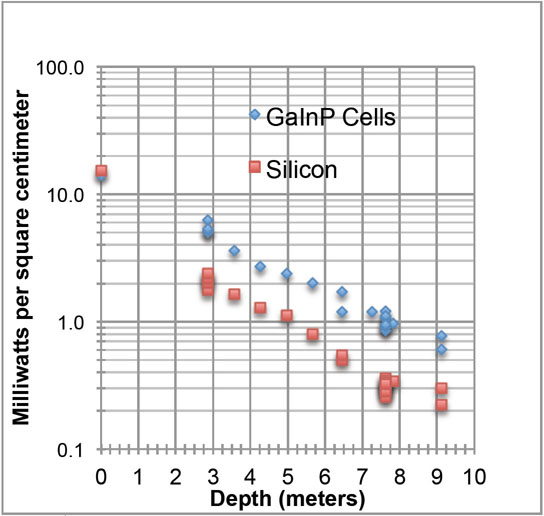
Power density of GaInP and crystalline silicon cells, underwater, as a function of depth. Credit: U.S. Naval Research Laboratory
New research from the U.S. Naval Research Laboratory shows that high-quality gallium indium phosphide (GaInP) cells produce useful solar power underwater, with initial results at a maximum depth of 9.1 meters revealing output to be 7 watts per square meter of solar cells.
Scientists at the U.S. Naval Research Laboratory, Electronics Science and Technology Division, dive into underwater photovoltaic research to develop high bandgap solar cells capable of producing sufficient power to operate electronic sensor systems at depths of 9 meters.
Underwater autonomous systems and sensor platforms are severely limited by the lack of long-endurance power sources. To date, these systems must rely on on-shore power, batteries, or solar power supplied by an above-water platform. Attempts to use photovoltaics have had limited success, primarily due to the lack of penetrating sunlight and the use of solar cells optimized more towards the unimpeded terrestrial solar spectrum.
“The use of autonomous systems to provide situational awareness and long-term environment monitoring underwater is increasing,” said Phillip Jenkins, head, NRL Imagers and Detectors Section. “Although water absorbs sunlight, the technical challenge is to develop a solar cell that can efficiently convert these underwater photons to electricity.”
Even though the absolute intensity of solar radiation is lower underwater, the spectral content is narrow and thus lends itself to high conversion efficiency if the solar cell is well matched to the wavelength range. Previous attempts to operate solar cells underwater have focused on crystalline silicon solar cells and more recently, amorphous silicon cells.
High-quality gallium indium phosphide (GaInP) cells are well suited for underwater operation. GaInP cells have high quantum efficiency in wavelengths between 400 and 700 nanometers (visible light) and intrinsically low dark current, which is critical for high efficiency in low light conditions.
The filtered spectrum of the sun underwater is biased toward the blue/green portion of the spectrum and thus higher bandgap cells such as GaInP perform much better than conventional silicon cells, states Jenkins.
Preliminary results at a maximum depth of 9.1 meters reveal output to be 7 watts per square meter of solar cells, sufficient to demonstrate there is useful solar power to be harvested at depths commonly found in nearshore littoral zones.









Be the first to comment on "GaInP Cells Produce Useful Underwater Solar Energy"